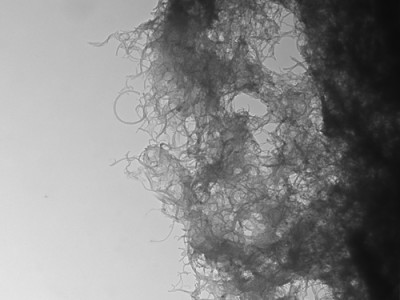Fibers (Synthetic)
Synthetic fibers represent a category of highly engineered polymers that are submitted to Microtrace for a variety of investigations that include: product development, forensic analysis, failure investigations, and patent litigation.
Fiber Properties
The characterization of fiber properties ranging from polymer characterization, cross section, optical properties such as refractive index and birefringence, fluorescence, and ultraviolet, visible and near-infrared spectroscopy, fillers, and extenders are all readily addressed through the analytical experience of our scientists. In addition to traditional fibers and micro-fibers, we have also conducted extensive research into the properties of various nanofibers and their nanotube precursor materials using high resolution electron microscopy.
Forensic Analysis
Microtrace and its scientists have been a pioneer in the field of forensic fiber identification. While most laboratories will only accept fiber evidence if a possible source fiber is submitted, Microtrace has assisted agencies in numerous investigative analyses whereby information about the manufacturer and end use of a fiber was determined with no reference material.
In addition to numerous presentations, publications, successful cases, and teaching around the world, Skip Palenik was a charter member of what is now the National Institute of Justice sponsored Scientific Working Group on Fiber Analysis and helped to produce the current “state of the art” for forensic fiber analysis.
Microtrace continues to push the bound of fiber analysis, analyzing smaller and smaller fragments, extracting more information, and pursuing research into the forensic identification of colorants. This has resulted in numerous successes in supporting the factual chain of events in criminal activities, which has been used by our clients, which have represented both the prosecution and defense.
Fabrics
The properties, microstructure, and ultimately the fibers, which define a fabric can provide information that can be of assistance to both fabric developers and forensic investigators. Microtrace has experience working with fabrics comprised of a wide variety of materials ranging from woven and knit fibers, to those comprised of non-wovens, and even nanofibers.
Collectibles
Drawing from the properties of historic fibers in our unparalleled fiber reference collections, our scientists have assisted historical investigations into the authenticity of artifacts ranging from ancient book bindings, to clothing purportedly worn by Hitler, to a lampshade supposedly constructed of human skin and stitched together with an early nylon fiber.
Related standardized methods: ASTM D123, D276, D629, D1776, D3822, D4491, E2224, E2225, E2227, E2228
How May We Help You?
Contact usto discuss your project in more detail.








